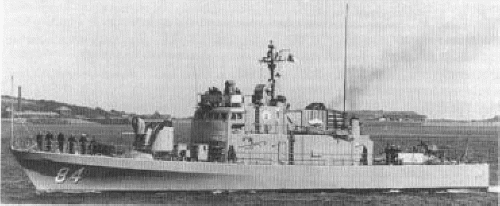

Asheville 1968

Asheville 1970

Beacon 1970
| No | Name | Yard No | Builder | Laid down | Launched | Comm | Fate |
| PGM84, 4.1967- PG84 | Asheville | Tacoma BB | 4.1964 | 1.5.1965 | 8.1966 | stricken 1.1977 | |
| PGM85, 4.1967- PG85 | Gallup | Tacoma BB | 4.1964 | 15.6.1965 | 10.1966 | stricken 10.1984 | |
| PG86 | Antelope | Tacoma BB | 6.1965 | 18.6.1966 | 11.1967 | stricken 10.1977 | |
| PG87 | Ready | Tacoma BB | 6.1965 | 12.5.1967 | 1.1968 | stricken 10.1977 | |
| PG88 | Crockett | Tacoma BB | 1965 | 4.6.1966 | 6.1967 | stricken 12.1976 | |
| PG89 | Marathon | Tacoma BB | 6.1966 | 22.4.1967 | 5.1968 | stricken 12.1976 | |
| PG90 | Canon | Tacoma BB | 6.1966 | 10.6.1967 | 7.1968 | stricken 10.1984 | |
| PG92 | Tacoma | Tacoma BB | 7.1967 | 13.4.1968 | 7.1969 | stricken 12.1995, to Colombia (Quitasueño) | |
| PG93 | Welch | Peterson, Sturgeon Bay | 5.1967 | 25.7.1968 | 9.1969 | stricken 4.1995, to Colombia (Albuquerque) | |
| PG94 | Chehalis | Tacoma BB | 1967 | 8.6.1968 | 11.1969 | auxiliary 10.1977 | |
| PG95 | Defiance | Peterson, Sturgeon Bay | 10.1967 | 1968 | 9.1969 | to Turkey 6.1973 (Yıldırım) | |
| PG96 | Benicia | Tacoma BB | 4.1969 | 20.12.1969 | 4.1970 | to South Korea 10.1971 (갈매기 11 [Paek Ku 11]) | |
| PG97 | Surprise | Peterson, Sturgeon Bay | 5.1968 | 7.12.1968 | 10.1969 | to Turkey 2.1973 (Bora) | |
| PG98 | Grand Rapids | Tacoma BB | 1969 | 4.4.1970 | 9.1970 | auxiliary 10.1977 | |
| PG99 | Beacon | Peterson, Sturgeon Bay | 7.1968 | 17.5.1969 | 11.1969 | to Greece 11.1989 (Ορμή [Ormi]) | |
| PG100 | Douglas | Tacoma BB | 1969 | 19.6.1970 | 2.1971 | stricken 10.1977 | |
| PG101 | Green Bay | Peterson, Sturgeon Bay | 11.1968 | 14.6.1969 | 12.1969 | stricken 10.1977, to Greece (Τόλμη [Tolmi]) |
|
Displacement standard, t |
225 |
|
Displacement full, t |
245 |
|
Length, m |
46.9 pp 50.1 oa |
|
Breadth, m |
7.28 |
|
Draught, m |
2.90 |
|
No of shafts |
2 |
|
Machinery |
CODOG: 2 Cummins 875V12 diesels / 1 General Electric LM-1500 Mk 7 gas turbine |
|
Power, h. p. |
1450 / 12500 |
|
Max speed, kts |
16 / 40 |
|
Fuel, t |
diesel / gas turbine oil 50 |
|
Endurance, nm(kts) |
1700(16) |
|
Armament |
1 x 1 - 76/50 Mk 34, 1 x 1 - 40/60 Mk 3, 2 x 2 - 12.7/90 |
|
Electronic equipment |
SPS-53, SPG-50 radars |
|
Complement |
28 |
Project history: These gas turbine 'motor gunboats' were a product of the Kennedy era, with its Presidential support for small craft and its preoccupation with Cuba. Originally a diesel design was proposed, a natural outgrowth of PGMs built for many US allies and suited for river and coastal operations. However, some within the Bureau of Ships noted that the advent of gas turbines for main propulsion made a much more advanced design possible, their high speed was a dubious advantage, but they did prove extremely useful in riverine warfare, in some cases sustaining considerable damage and in all cases displaying endurance well beyond design goals.
The Asheville class were also used to test 'special warfare' coastal infiltration techniques, benefiting from their small radar cross-section and in many US and NATO exercises they simulated Soviet small missile craft (Osa and Komar types). In addition, after Vietnam, four units in the Mediterranean were assigned by the then CNO, Admiral Zumwalt, to a 'counter-tattletale' role, following Soviet warships to provide positive warning of any imminent Soviet missile attack on the Sixth Fleet. In this role they were armed with a surface-to-surface variant of the US Standard anti-aircraft missile, with two launchers aft and an additional pair of reloads forward of the launchers. Admiral Zumwalt later used this experience to justify the PHM programme.
Cavitation generally limited their maximum speed to something less than the design figure always quoted, although at the time it was stated that the provision of new propellers would have allowed them to reach design speed. In service they had a bad reputation for discomfort in a seaway, although they were good sea boats and could ride out very severe storms. Thus proponents of the PHM could argue that the Ashevilles had demonstrated the utility of small fast surface-attack craft and that hydrofoil design could overcome their bad riding characteristics.
PG86 and 87 had the Dutch-developed Mk 87 fire control system, a close relative of the Mk 92 of the PHMs and FFGs, employing a computer and automatic aiming; the others all had the Second World War Mk 63 to control their 76mm guns. Although up to twenty-two were planned, rising costs and the absence of a clear mission (particularly in the context of the costs of the Vietnam War) cut short the programme, and the absence of a rationale shows in the quick disposal of most of the class.
Modernizations: 1971-75, PG86, 87, 96, 98, 100: - 1 x 1 - 40/60; + 2 x 1 Standard ARM SSM (2 AGM-78)
Naval service: No significant events.

Asheville 1974
© Ivan Gogin, 2015